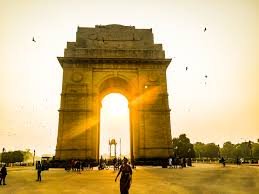A sharp jolt caught millions of Delhi-NCR residents off guard on the morning of July 10, 2025. Fans began to sway, windows rattled, and in a matter of seconds, people rushed out of homes, offices, and schools. What they had just experienced was a magnitude 4.4 earthquake, with its epicentre alarmingly close — near Jhajjar in Haryana, only about 60 kilometers from the heart of Delhi.
While no damage was reported, the quake raised new questions that demand serious attention. Why is Delhi experiencing more tremors? How dangerous are shallow quakes? And are we truly prepared?
What Happened on July 10?
At exactly 9:04 AM IST, seismic sensors registered a 4.4 magnitude earthquake at a depth of 10 kilometers — shallow enough for widespread tremors to be strongly felt. The National Centre for Seismology pinpointed the epicentre near Jhajjar, a location not far from Gurugram and Rohtak. Tremors were reported from across Delhi, Noida, Ghaziabad, Faridabad, Sonipat, and even parts of Western UP.
“I was brushing my teeth and suddenly the mirror started shaking. It lasted only a few seconds, but it felt longer than usual,” said Mansi Thakur, a resident of Noida Sector 77.
Delhi Metro trains briefly paused service. Schools and office buildings saw people rushing to open grounds. It wasn’t catastrophic — but it was intense.
Why This Quake Felt So Strong
Although a 4.4 magnitude event isn’t considered large by seismic standards, this one was shallow, with energy released just 10 kilometers beneath the surface. That proximity to the Earth’s surface amplifies the sensation of shaking — especially in densely built-up areas like Delhi-NCR.
“The shaking felt strong because it was shallow. A deeper quake of the same magnitude wouldn’t have been as perceptible,” explained Dr. K.K. Sinha, a retired geophysicist formerly with IIT Roorkee.
A Recent Pattern: Delhi’s Earthquake Timeline
This wasn’t the first time in 2025 that Delhi felt the earth move. Earlier this year, on February 17, a magnitude 4.0 earthquake struck with an epicentre in Dhaula Kuan, within Delhi itself. On March 28, tremors from a massive 7.7 earthquake in Myanmar were felt across North India.
Key Earthquakes Felt in Delhi-NCR
- July 10, 2025 – Magnitude 4.4 – Epicentre: Jhajjar, Haryana – Shallow depth, widely felt
- February 17, 2025 – Magnitude 4.0 – Epicentre: Dhaula Kuan, South Delhi – Epicentre within city limits
- March 28, 2025 – Magnitude 7.7 – Epicentre: Sagaing, Myanmar – Distant but strong tremors
- November 12, 2023 – Magnitude 5.4 – Epicentre: Nepal – Light shaking across NCR
- October 3, 2023 – Magnitude 4.8 – Epicentre: Faridabad – Moderate shaking, minimal impact
Why Delhi Is At Risk: The Seismic Context
Delhi falls in Seismic Zone IV, one of India’s highest-risk earthquake zones. Its location — between the Himalayan thrust belts and the Aravalli tectonic lineament — makes it prone to both local and regional seismic events.
The Indian Plate is moving northwards, colliding with the Eurasian Plate and generating huge tectonic stress across the region. That stress is occasionally released in bursts — like the July 10 event — but the concern remains that a much larger release could be on the horizon.
Are Earthquakes Becoming More Frequent?
While the Indian subcontinent is no stranger to tectonic activity, Delhi’s recent frequency of tremors has increased in both public awareness and occurrence. Experts caution that this could be the buildup to a larger seismic event or simply part of a natural cycle.
“Micro seismic activity is often a pressure release — but sometimes it’s also a sign that stress is redistributing along fault lines,” said Anupam Mehta, a structural safety consultant. “What’s worrying is not just the frequency, but how close the epicentres have been to densely populated zones.”
Earthquake Alerts: Why Many Didn’t Get One
A key concern raised after the July 10 quake was the failure of Google’s Earthquake Alert System for many users. This Android-based early warning system uses a network of phone sensors to detect tremors and push alerts — but only if:
- Location services are enabled
- Wi-Fi or mobile data is active
- Google Play Services has background access
“Most people don’t realize that the alert won’t work if your phone is in battery saver mode or if you’ve disabled location,” noted a spokesperson from Google India.
To enable alerts, Android users can go to Settings > Safety & Emergency > Earthquake Alerts and make sure all permissions are turned on.
Delhi’s Structural Vulnerability
Despite the warnings, Delhi’s built environment remains highly vulnerable. Many buildings, especially in Karol Bagh, Paharganj, Old Delhi, and unauthorized colonies, were constructed without seismic safety standards. Even newer high-rises in Gurgaon and Noida may not meet the latest building codes.
According to the Delhi Disaster Management Authority, retrofitting has been initiated in key hospitals and schools, but implementation is slow and limited mostly to government buildings.
“If this had been a 6.5 instead of a 4.4, we could have seen wall cracks, stairwell collapses, even fatalities,” Mehta warned.
What To Do During a Quake
Being prepared can make all the difference. Here’s what to do during an earthquake:
- Indoors: Drop under a sturdy table, cover your head, and hold on
- Outdoors: Move to an open space, away from buildings, poles, or trees
- In a vehicle: Stop in a clear area and stay inside until shaking stops
Keep an emergency go-bag with water, torch, medicines, and important documents. Make sure your family knows basic protocols and safe zones in your home.
The Bigger Warning
The July 10 earthquake was mild in magnitude but deep in significance. It reminded us that Delhi’s seismic risk is not theoretical. With tremors becoming more common, epicentres shifting closer, and infrastructure still catching up, this event should not be dismissed as just another tremor.
It’s a wake-up call — and we’d be wise to listen.
FAQs
Was there an earthquake in Delhi on July 10, 2025?
Yes, a magnitude 4.4 earthquake struck Delhi-NCR on the morning of July 10, 2025, at around 9:04 AM IST. The tremors were widely felt across Delhi, Gurugram, Noida, Ghaziabad, and surrounding areas.
Where was the epicentre of the July 10 earthquake?
The epicentre was near Jhajjar, Haryana, approximately 60 kilometers from central Delhi. Because the quake was shallow—just 10 kilometers deep—the shaking felt stronger than usual.
Why are earthquakes becoming more frequent in Delhi-NCR?
Delhi lies in Seismic Zone IV, a region prone to moderate to severe earthquakes. The area sits near the collision zone of the Indian and Eurasian tectonic plates, with multiple fault lines running beneath and around the city.
Did the earthquake cause any damage in Delhi?
No damage or injuries were reported after the July 10 earthquake. However, experts warn that Delhi’s infrastructure is vulnerable, especially older buildings and unregulated constructions, which could pose risks in larger events.
Why didn’t I receive a Google Earthquake Alert?
Google’s Earthquake Alert System only works when location services are enabled, Wi-Fi or mobile data is active, and Google Play Services has proper permissions. Battery saver or app restrictions may prevent alerts from being delivered.
What should I do during an earthquake in Delhi?
If you’re indoors, drop under a table, cover your head, and hold on. If outdoors, move to an open area away from buildings and electrical poles. If driving, stop in a safe place and stay inside the vehicle until the shaking stops.

